Oculus Rift Controllers, VR Games, And Software Features Announced
by Brett Howse on June 11, 2015 11:15 PM EST- Posted in
- VR
- Oculus Rift
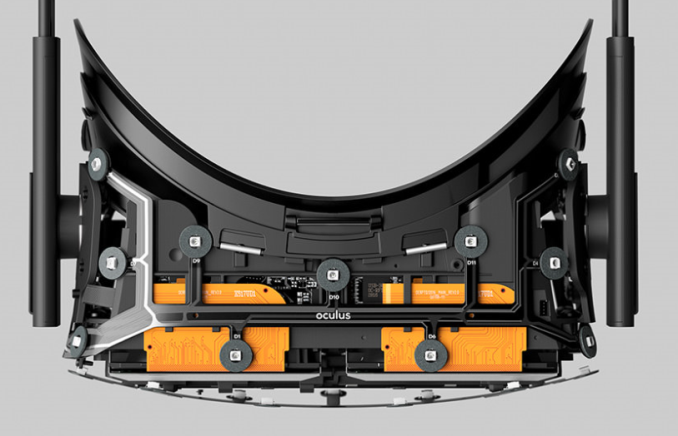
On the eve of E3, Oculus held a livestream to announce some more details of the upcoming Oculus Rift Virtual Reality headset. Just about a month ago, they announced that they were targeting a Q1 2016 release, and with that time fast approaching, they have given some more details on the unit itself, as well as what kind of experiences you can expect with it. Oculus has re-affirmed the Q1'16 launch date, and now we finally know the specs for the retail consumer unit.
One of the key points they brought up was that the unit itself needs to be comfortable, and part of that comfort is weight. January seems like a long time ago when I got to try out the Crescent Bay version of the Rift, but at the time I was impressed with how it felt, and I don’t recall the weight at all which I guess is the point. The final, consumer version of the Rift in turn is close to the Crescent Bay version, with further enhancements for both the electronics and the overall fit itself to bring down the weight and make it more comfortable.
Audio is also a big part of the experience, and the included headphones on Crescent Bay were quite good. For the consumer version Oculus is going in a similar direction, but today they have also confirmed that you will be able to wear your own headphones as well if you prefer that. The directional audio is a key piece to the immersion and the Oculus team has done a great job with that aspect.
Another part though is the displays. When we met with Oculus’s CEO Brendan Iribe at CES, one of the interesting things he told us was that they have found that by interleaving a black frame in between each video frame, it can prevent ghosting. In order to do this though, the refresh rate needs to be pretty high with the unit we tested running at 90 Hz. Today they announced a tiny bit about the hardware, and the Oculus Rift will ship with two OLED panels designed for low-persistence. Oculus has previously commented that they're running at a combined 2160x1200, and while they don't list the individual panel size, 1080x1200 is a safe bet. The OLED panels are behind optical lenses which help the user focus on a screen so close to their eye without eye strain, and the inter-pupil distance is important. There will be an adjustment dial that you can tweak to make the Rift work best for you.
Tracking of your head movement is done with the help of an IR LED constellation tracking system, unlike the Hololens which does all of the tracking itself with its own cameras. This makes installation a bit more difficult but should be more precise and reduce the overall weight of the head unit.
For those that wear glasses, the company has improved the design to better allow for glasses, and they also make it easy to replace the foam surrounding the headset.
One thing that was really not known yet was what kind of control mechanism Oculus was going to employ. In the demos I did at CES, there was no interaction, and you were basically a bystander. Oculus announced today that every Rift will be shipping with an Xbox One wireless controller and the just announced wireless adapter for Windows. This is a mutually beneficial agreement to say the least, with Microsoft getting in on the VR action and Oculus getting access to a mature controller design. Oculus even stated that the controller is going to be the best way to play a lot of VR games. However they also announced their own controller for a new genre of VR games to give an even more immersive experience.
Oculus Touch is the name of new controller system that Oculus has come up with. Each controller has a traditional analog thumbstick, two buttons, an analog trigger, and a “hand trigger” input mechanism. The two controllers are mirror images of each other, with one for each hand. They are wireless as well, and use the IR LED tracking system as well in order to be used in space. The controllers will also offer haptic feedback so that they can be used to simulate real world touch experiences. They also detect some finger poses (not full finger tracking) in order to perform whatever task is assigned to that pose. These should be pretty cool and I can’t wait to try them out.
Hardware is certainly part of the story, but software is going to be possibly an even bigger part. The Rift needs to launch with quality games, and it looks like Oculus has some developers on board with EVE: Valkyrie, Chronos, and Edge of Nowhere being some of the featured games.
They also showed off their 2D homescreen which they are projecting into the 3D rift world. There will be easy access to social networks and of course multiplayer gaming in virtual reality.
In addition to the Xbox controller, Oculus has also worked with Microsoft to enable the upcoming Xbox Game Streaming into the Rift, so that you can be fully immersed. This will not magically make Xbox games 3D VR worlds, but instead will project the Xbox game into a big 2D screen inside the Rift and block out all distractions.
I’ve been a bit of a VR skeptic, but my time with the Rift was pretty cool. I can see a lot of applications for this outside of gaming, but of course gaming is going to be a big part of VR and Oculus looks to be lining up a pretty nice looking launch. A big part is going to be quality titles for the Rift and Oculus is working hard on that aspect. The hardware is now pretty polished.
Source: Oculus


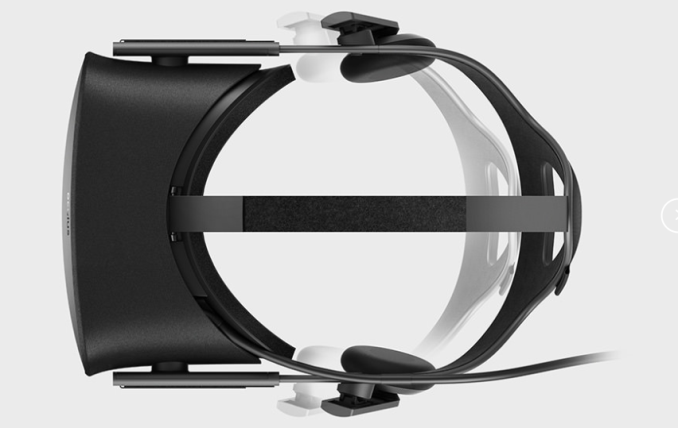
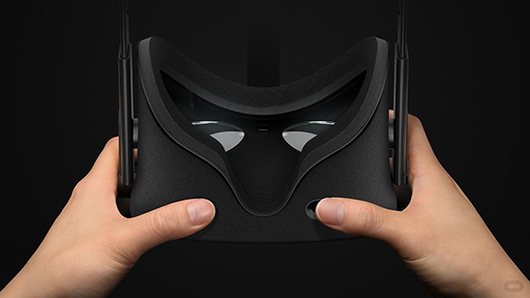
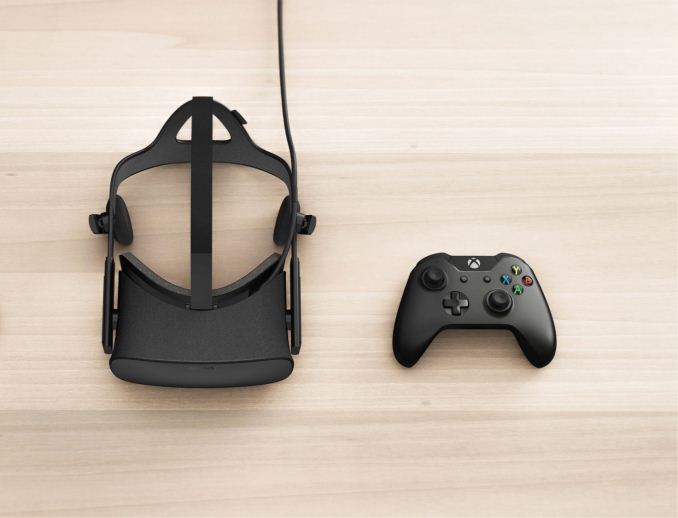
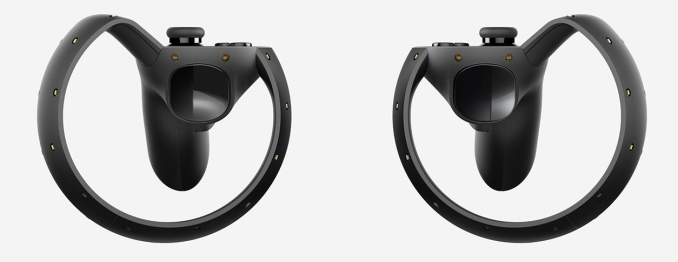
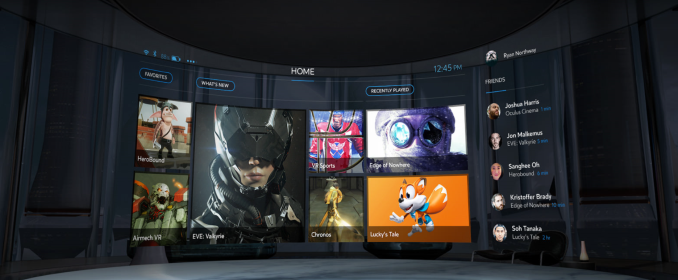








44 Comments
View All Comments
flexy - Wednesday, June 24, 2015 - link
I tend to agree although we VR "enthusiasts" are always met with a lot of skepticism, something I cannot understand. I knew that this is the future the first time I've been in an Imax, at a time where the idea of a 3D TV at home, let alone VR for the masses was still a dream many years away. I personally predict this not only to "take off" for games, but it will likely revolutionize EVERYTHING from social media, to "watching" movies, sports etc..etc.. The step from "2D surfaces" like TV or movie screens to getting really immersed into a virtual environment is just too big that this simply CAN not go by just as a fluke. Let me compare this to...horses vs. cars/planes....or photographs vs. movies. People are still just skeptical because because of things like needing to wear some awkward device (understandable)....but those are all technical hurdles than will be solved in time. (People today are not carrying 300lbs cathode ray tubes around, you can watch movies on stamp-sized mobile device today. In other words: The tech will get better, devices faster, smaller, more comfortable etc.)flexy - Wednesday, June 24, 2015 - link
>>In multiplayer, I expect that people in VR will dominate the people using screens as long as the game has realistic physics. Millions of years of evolution honed our ability to interact with environments.
>>
The irony is that interacting (or watching a movie, or playing a game etc.) from a 3D world projected onto a flat 2D screen is more abstract and less "natural"..and I "predict" this silliness will be forgotten within the next...hmm..20 years. OF COURSE everything will happen in real 3D space by then and people will think back and laugh at the idea how we played games or watched movies in 2D. You know it, I know it this will happen :)
Guspaz - Monday, June 15, 2015 - link
Since effective VR games need to be designed from the ground up as primarily VR games (in the same sense that you're not going to take a high-end PC game and stick it on a smartphone) I don't think you'll see that many games with that sort of an option. It's such a huge difference in how the game needs to be made, from the "latency and framerate are king" aspect to the graphics engine to the UI to the gameplay.flexy - Wednesday, June 24, 2015 - link
It is true that game devs need to think anew, but I don't see this is a problem whatsoever. The rest of the things you mention, latency, frame rates etc...are hideously tiny "obstacles" which will be solved as technology progresses, as PCs and GPUs get faster. The same with the size of the actual device which IN MY OPINION "for the masses" is still possibly a turn-off...but this too is just a matter of time until tech is so far advanced and goggles etc. get as small and comfortable as glasses.Wolfpup - Friday, June 19, 2015 - link
Well not just that, it may be the best input method for VR. Sure it SOUNDS nifty to say it needs some new input method, but hte reality is all the alternate input methods we've tried other than regular pad descended from the NES pad or a mouse/keyboard don't actually work, and destroy immersion.I'd assume using a good controller but also have the immersion of being able to look around would just make things more immersive than they already are. Wii, Kinnect, Move don't actually work, and so would break immersion, and probably any other input method they made up would too-besides you're already getting a 'head look' input that you don't have normally just by moving your head.
Wolfpup - Friday, June 19, 2015 - link
I'm not sure whether alternate controls could help, or hurt. They might wind up being terrible, just as they were for....well, absolutely everything except a standard controller and mouse/keyboard.It makes total sense to me...I mean you're playing a first person game, you already know how to control it, but you can look around in the game world too just by looking around. That sounds intuitive to me, and it actually works/won't hurt gameplay (hopefully).
Honestly, the idea of playing a game I actually like, a good FPS or something like Bioshock or Fallout or something...playing something I actually love and want to play anyway, but playing it on one of those things where everything's blocked out and I can look around and see nothing but game world? I have to admit I'd actually like to try that.
Of course, I don't know that One really has the horsepower to drive this....hmm.
You need a way faster refresh rate than the console's can draw...but maybe it just needs to refresh that fast and the frame rate is okay. The resolution's even higher than 1080p, and the Xbox already can't do 1080p, sooooo clearly they'd have to render at 900p or below and scale up, and drop down graphics even more if they need to hit like 60 or 90FPS instead of 30ish.
Even still I guess it's not TOO far outside its capabilities...like I'm sure One could do a last gen game, run it at a high resolution and at 90fps or whatever, so long as it's not as detailed as current gen stuff can be.
Wolfpup - Friday, June 19, 2015 - link
Yeah, just using an Xbox controller is smart. Seems win/win. Right out of the gate it has a real, good controller that works with Xbox One and PC games, which also makes it feel like "oh hey, this thing already plays games" right out of the gate. And Microsoft doesn't have to worry too much about if they'll lose sales to not having a VR headset, and maybe places a One controller in more people's hands, selling more PC games and Ones.ClamShall - Friday, June 12, 2015 - link
Looking forward to watching immersive porn on this thing.jrbris - Friday, June 12, 2015 - link
"That groinal attachment's supposed to have a lifetime's guarantee. You've worn it out nearly three weeks."hbsource - Friday, June 12, 2015 - link
She wasn't jailbait. She was 17.